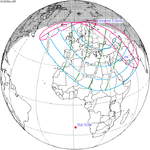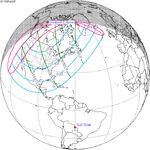Solar eclipse of May 1, 2079
| Solar eclipse of May 1, 2079 | |
|---|---|
 Map | |
| Type of eclipse | |
| Nature | Total |
| Gamma | 0.9081 |
| Magnitude | 1.0512 |
| Maximum eclipse | |
| Duration | 175 sec (2 m 55 s) |
| Coordinates | 66°12′N 46°18′W / 66.2°N 46.3°W |
| Max. width of band | 406 km (252 mi) |
| Times (UTC) | |
| Greatest eclipse | 10:50:13 |
| References | |
| Saros | 149 (24 of 71) |
| Catalog # (SE5000) | 9685 |
A total solar eclipse will occur on Monday, May 1, 2079, with a maximum eclipse at 10:48:25.6 UTC (10:50:12.8 TD). A solar eclipse occurs when the Moon passes between Earth and the Sun, thereby totally or partly obscuring the image of the Sun for a viewer on Earth. A total solar eclipse occurs when the Moon's apparent diameter is larger than the Sun's, blocking all direct sunlight, turning day into darkness. Totality occurs in a narrow path across Earth's surface, with the partial solar eclipse visible over a surrounding region thousands of kilometres wide. The eclipse will be visible in Greenland, parts of eastern Canada (including Newfoundland and Labrador, New Brunswick, Nova Scotia and Prince Edward Island) and parts of the northeastern United States (including Maine, New Hampshire, Vermont, Connecticut, Rhode Island, Massachusetts, New York, Pennsylvania and New Jersey).
Visible cities[]
The Path of totality will start in eastern Pennsylvania. A total eclipse will be visible along the path of Philadelphia, New York City, Boston and Portland in the United States. Partial eclipses will be visible in Charlotte, Richmond, Cleveland, Detroit, Chicago, Washington, D.C., and Buffalo. In Canada, the total eclipse can be visible in Halifax, and St. John, while the partial eclipse can be seen in Montreal, Toronto, Ottawa, and most of northern Canada. The path then passes directly through Nuuk, making it visible to most of Greenland. The path will end near the Bering Strait. a partial eclipse can be visible in a very small part of South America, Northern Africa, Europe and Northern Asia (Mostly Russia).
Details[]
Delta T: 1 minute, 47.3 seconds
Magnitude = 1.05116
Obscuration = 1.10494
Gamma = 0.90808
Greatest eclipse = 01 May 2079 10:48:25.6 UTC (10:50:12.8 AT)
Sun right ascension = 2 hours, 35 minutes, 18.8 seconds
Sun declination = 15 degrees, 12 minutes, 6.8 seconds north of the celestial equator
Moon right ascension = 2 hours, 33 minutes, 47.0 seconds
Moon declination = 16 degrees, 2 minutes, 36.5 seconds north of the celestial equator
Sun diameter = 1905.2 arcseconds
Moon diameter = 1989.4 arcseconds
Path width at greatest eclipse = 405.7 km (252.1 mi)
Path width at greatest duration = 404.8 km (251.5 mi)
Totality at greatest eclipse = 2 minutes, 54 seconds, 910 milliseconds
Totality at greatest duration = 2 minutes, 54 seconds, 920 milliseconds
Related eclipses[]
Solar eclipses 2076–2079[]
This eclipse is a member of a semester series. An eclipse in a semester series of solar eclipses repeats approximately every 177 days and 4 hours (a semester) at alternating nodes of the Moon's orbit.[1]
| Solar eclipse series sets from 2076–2079 | ||||
|---|---|---|---|---|
| Ascending node | Descending node | |||
| Saros | Map | Saros | Map | |
| 119 | June 1, 2076 Partial |
124 | November 26, 2076 Partial | |
| 129 | May 22, 2077 Total |
134 | November 15, 2077 Annular | |
| 139 | May 11, 2078 Total |
144 | November 4, 2078 Annular | |
| 149 | May 1, 2079 Total |
154 | October 24, 2079 Annular | |
Saros 149[]
Solar saros 149, repeating every about 18 years and 11 days, contains 71 events. The series started with a partial solar eclipse on August 21, 1664. It has total eclipses from April 9, 2043, to October 2, 2331. The series ends at member 71 as a partial eclipse on September 28, 2926. The longest total eclipse will be on July 17, 2205, at 4 minutes and 10 seconds.[2]
| Series members 15–25 occur between 1901 and 2100: | ||
|---|---|---|
| 15 | 16 | 17 |
 January 23, 1917 |
 February 3, 1935 |
 February 14, 1953 |
| 18 | 19 | 20 |
 February 25, 1971 |
 March 7, 1989 |
 March 19, 2007 |
| 21 | 22 | 23 |
 March 29, 2025 |
 April 9, 2043 |
 April 20, 2061 |
| 24 | 25 | |
 May 1, 2079 |
 May 11, 2097 | |
Inex series[]
This eclipse is a part of the long period inex cycle, repeating at alternating nodes, every 358 synodic months (≈ 10,571.95 days, or 29 years minus 20 days). Their appearance and longitude are irregular due to a lack of synchronization with the anomalistic month (period of perigee). However, groupings of 3 inex cycles (≈ 87 years minus 2 months) comes close (≈ 1,151.02 anomalistic months), so eclipses are similar in these groupings. In the 19th century:
- Solar saros 140: total solar eclipse of October 29, 1818
- Solar saros 141: annular solar eclipse of October 9, 1847
- Solar saros 142: total solar eclipse of September 17, 1876
| Inex series members between 1901 and 2100: | ||
|---|---|---|
 August 30, 1905 (Saros 143) |
 August 10, 1934 (Saros 144) |
 July 20, 1963 (Saros 145) |
 June 30, 1992 (Saros 146) |
 June 10, 2021 (Saros 147) |
 May 20, 2050 (Saros 148) |
 May 1, 2079 (Saros 149) |
||
In the 22nd century:
- Solar saros 150: partial solar eclipse of April 11, 2108
- Solar saros 151: annular solar eclipse of March 21, 2137
- Solar saros 152: total solar eclipse of March 2, 2166
- Solar saros 153: annular solar eclipse of February 10, 2195
Tritos series[]
This eclipse is a part of a tritos cycle, repeating at alternating nodes every 135 synodic months (≈ 3986.63 days, or 11 years minus 1 month). Their appearance and longitude are irregular due to a lack of synchronization with the anomalistic month (period of perigee), but groupings of 3 tritos cycles (≈ 33 years minus 3 months) come close (≈ 434.044 anomalistic months), so eclipses are similar in these groupings.
| Series members between 1901 and 2100 | |||
|---|---|---|---|
 September 9, 1904 (Saros 133) |
 August 10, 1915 (Saros 134) |
 July 9, 1926 (Saros 135) | |
 June 8, 1937 (Saros 136) |
 May 9, 1948 (Saros 137) |
 April 8, 1959 (Saros 138) | |
 March 7, 1970 (Saros 139) |
 February 4, 1981 (Saros 140) |
 January 4, 1992 (Saros 141) | |
 December 4, 2002 (Saros 142) |
 November 3, 2013 (Saros 143) |
 October 2, 2024 (Saros 144) | |
 September 2, 2035 (Saros 145) |
 August 2, 2046 (Saros 146) |
 July 1, 2057 (Saros 147) | |
 May 31, 2068 (Saros 148) |
 May 1, 2079 (Saros 149) |
 March 31, 2090 (Saros 150) | |
Metonic series[]
The metonic series repeats eclipses every 19 years (6939.69 days), lasting about 5 cycles. Eclipses occur in nearly the same calendar date. In addition, the octon subseries repeats 1/5 of that or every 3.8 years (1387.94 days). All eclipses in this table occur at the Moon's ascending node.
| 21 eclipse events, progressing from south to north between July 13, 2018 and July 12, 2094 | ||||
|---|---|---|---|---|
| July 12–13 | April 30-May 1 | February 16–17 | December 5–6 | September 22–23 |
| 117 | 119 | 121 | 123 | 125 |
 July 13, 2018 |
 April 30, 2022 |
 February 17, 2026 |
 December 5, 2029 |
 September 23, 2033 |
| 127 | 129 | 131 | 133 | 135 |
 July 13, 2037 |
 April 30, 2041 |
 February 16, 2045 |
 December 5, 2048 |
 September 22, 2052 |
| 137 | 139 | 141 | 143 | 145 |
 July 12, 2056 |
 April 30, 2060 |
 February 17, 2064 |
 December 6, 2067 |
 September 23, 2071 |
| 147 | 149 | 151 | 153 | 155 |
 July 13, 2075 |
 May 1, 2079 |
 February 16, 2083 |
 December 6, 2086 |
 September 23, 2090 |
| 157 | ||||
 July 12, 2094 | ||||
Notes[]
- ^ van Gent, R.H. "Solar- and Lunar-Eclipse Predictions from Antiquity to the Present". A Catalogue of Eclipse Cycles. Utrecht University. Retrieved October 6, 2018.
- ^ Saros Series Catalog of Solar Eclipses NASA Eclipse Web Site.
References[]
- Earth visibility chart and eclipse statistics Eclipse Predictions by Fred Espenak, NASA/GSFC
- Total solar eclipses
- 2079 in science
- 21st-century solar eclipses
- Future solar eclipses
- Solar eclipse stubs



